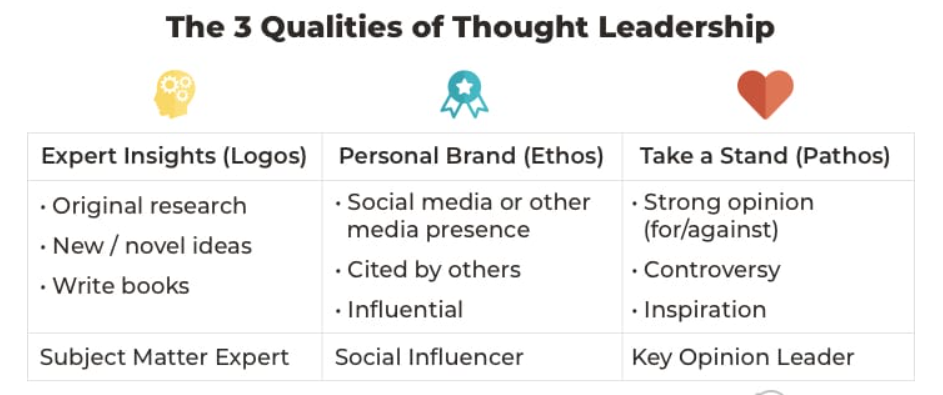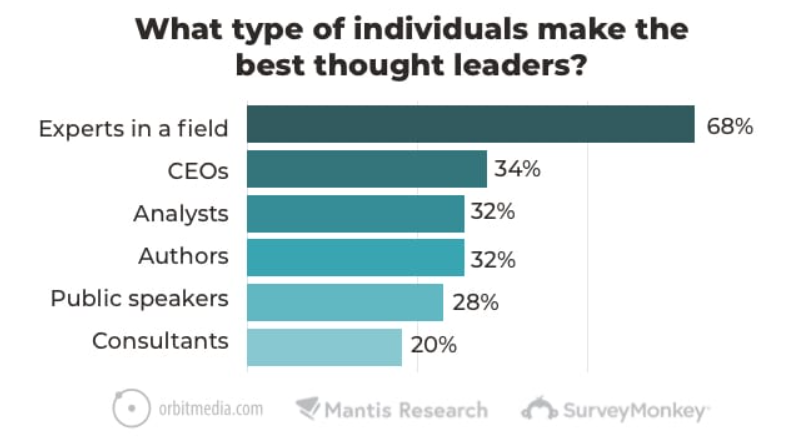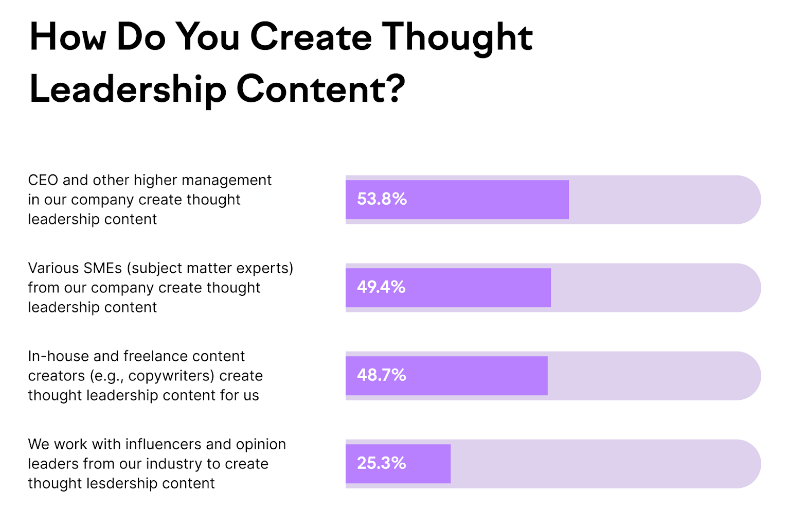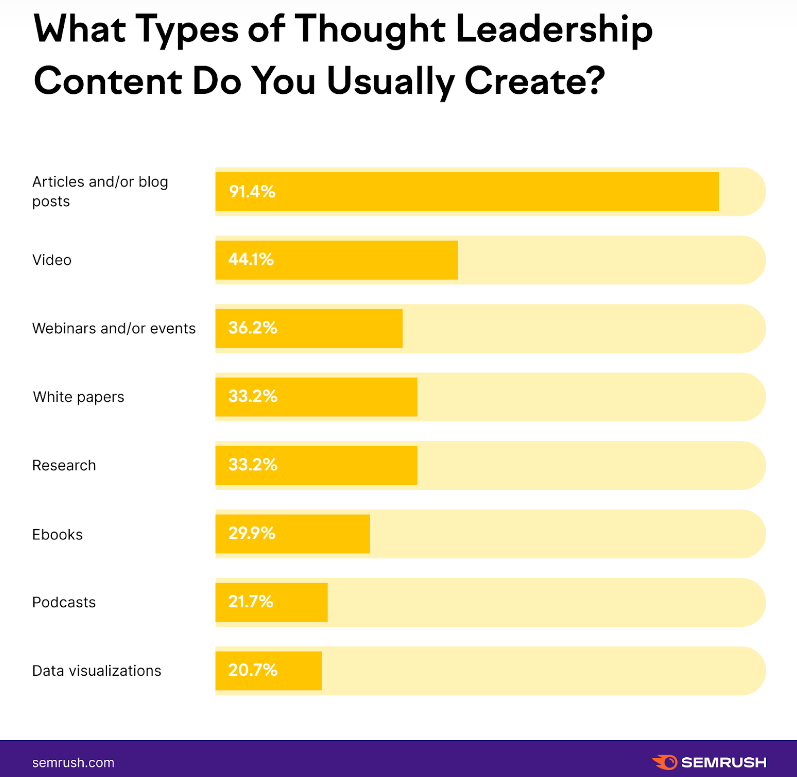So, you’re diving into the world of thought leadership marketing. Smart move. This isn’t just about pushing content; it’s about becoming a beacon in your industry, someone others look to for insights and guidance.
By reading this piece, you’ll get the lowdown on how thought leadership can transform not just how potential clients see you but also how they discover and decide on your brand.
We’ll walk through crafting a strategy that elevates your brand, developing compelling content that makes decision-makers take notice, and ensuring your wisdom reaches far and wide.
You’re set to learn tactics for leveraging social media effectively, measuring the success of your efforts with precision, attracting top talent through visibility as an industry leader, and even forging strategic partnerships thanks to newfound credibility.
Let’s make sure those hours spent creating content don’t go unnoticed.
Table Of Contents:
- What is Thought Leadership Marketing?
- When Should You Use Thought Leadership Content?
- Developing Your Thought Leadership Strategy
- Creating Compelling Thought Leadership Content
- Make Thought Leadership Visible
- Leveraging Social Media Platforms
- Measuring the Success of Your Thought Leadership Campaigns
- Thought Leadership Content Examples to Learn From
- Start Writing Exceptional Thought Leadership Content
What is Thought Leadership Marketing?
In the B2B sector, thought leadership marketing stands out by pushing boundaries and offering fresh insights. It’s more than just content; it’s about setting trends and guiding your target market.
This strategy plays a crucial role in brand discovery. Imagine scrolling through countless articles weekly. Over half of B2B decision-makers do this, seeking not just any content but valuable insights that can steer their decisions.
47% of these professionals discover brands leading to purchase decisions through thought leadership content. This shows its powerful impact on business growth and brand visibility.
Distinguishing between traditional marketing strategies and thought leadership is essential for understanding its value. While conventional methods focus on showcasing products or services directly, thought leadership delves deeper into solving industry challenges with innovative ideas.
The goal here is not only to present solutions but also to spark conversations around them, positioning your brand as an authority within your niche.

Source: Orbit Media
When Should You Use Thought Leadership Content?
Thought leadership is a great way for companies to establish credibility and build trust with their target audience. But when exactly is the right time to deploy this strategy?
Crafting Brand Awareness and Credibility
The journey towards becoming an industry leader begins with brand awareness, and what better way to achieve this than through sharing insightful, expert-level content?
Thought leadership pieces serve as a testament to your company’s expertise, helping you foster trust among potential customers. This type of content goes beyond mere advertising; it positions your brand as a reliable source of information — a critical factor in today’s information-saturated market.
As highlighted by the Content Marketing Institute, providing value without expecting anything in return can significantly boost your brand’s stature within the industry.
Fueling Connections Through Expertise Sharing
A unique aspect of thought leadership is its ability to humanize your brand. By featuring articles written by or about key team members — including founders — your company becomes more relatable.
Potential clients see faces behind the name, transforming abstract corporate entities into groups of real people dedicated to solving problems just like theirs. This connection fosters loyalty and can be especially potent when experts take definitive stances on pressing issues within their fields.
To truly harness the power of thought leadership content, visibility plays a crucial role. Making authors known builds stronger connections between them and their readership since consumers tend to place higher trust in individuals over faceless brands. Therefore, integrating personal insights from leaders within your organization not only enriches the quality but also amplifies engagement levels among targeted demographics.
Developing Your Thought Leadership Strategy
To elevate your brand and stand out as an industry leader, crafting a thought leadership strategy is key.
But where do you start?
First off, know who you’re talking to.
Define Your Target Audience
Finding your tribe means understanding their needs inside and out. It’s not just about demographics; it’s diving deep into what keeps them up at night.
Tools like Semrush can help shed light on the topics they search for, giving you valuable insight into creating content that resonates.
This step is crucial because 55% of B2B decision-makers will look elsewhere if your content doesn’t grab their attention in around 60 seconds. So make sure what you put out there speaks directly to them.
Research Your Target’s Needs
Now that you know who they are, it’s time to find out exactly what they need from someone in your position. Use platforms like AnswerThePublic to uncover the questions they’re asking online. This intel helps shape content that answers their biggest queries and positions you as the go-to source for insights.
The goal here is not just answering questions but doing so in a way that demonstrates deep expertise and unique perspectives — traits of a true thought leader.
A solid thought leadership strategy isn’t just about being seen — it’s about being remembered for bringing value nobody else does.

Creating Compelling Thought Leadership Content
Developing content that cements your status as an authority in your field isn’t just about churning out blog posts or white papers. It’s about bringing something new to the table.
A staggering 70% of professionals report that most thought leadership content they encounter doesn’t pack enough valuable insights. This shows a clear gap, one you can fill by conducting original research.
To get started, platforms like Ahrefs are invaluable for digging deep into what your audience craves. They let you uncover questions people ask but rarely find satisfactory answers to.
Conduct Original Research
Gone are the days when rehashing common knowledge could position someone as a leader. Today’s audience demands more; they seek unique perspectives backed by data they can trust.
This is where original research comes into play. Identify gaps in existing content and provide fresh insights or data-driven conclusions that truly add value to your target audience.
Beyond giving readers information, this approach enhances credibility significantly. When you share findings from a study that you conducted, it demonstrates not only expertise but also dedication to advancing understanding within your industry niche.
Select Topics That Matter to Your Audience
It’s tempting to focus solely on what interests you or aligns with your expertise, but for true engagement, it’s crucial to address the questions and challenges facing those you aim to serve.
Consider conducting surveys, engaging in social listening, or creating detailed audience personas as methods for uncovering these valuable insights.
Showcase Genuine Expertise
Expertise lies at the heart of all compelling thought leadership content. This doesn’t necessarily mean having decades of experience (although that certainly helps), but rather possessing deep knowledge about specific subjects within your industry.
If an area falls outside your expertise, consider leveraging interviews with subject matter experts as a method for enriching your content with authoritative perspectives.
Maintain Brand Consistency Across All Content
Ensure every piece of content reflects the core values and mission statement of your brand.
Adopt a consistent tone and style across all platforms where you publish content – from blog posts to social media updates – reinforcing brand recognition among audiences.
Regardless of format or channel, always try to educate and add value. These can be unique insights tailored toward solving problems faced by your readers.

Source: Semrush survey
Make Thought Leadership Visible
Your insightful content deserves an audience beyond those who stumble upon it organically through search engines or social media shares. Platforms like LinkedIn are goldmines for promoting thought leadership.
But it’s not just about posting articles; engaging directly with industry peers and potential clients can set you apart.
Comment on relevant posts, share valuable insights, and don’t shy away from starting conversations. This hands-on approach helps build your reputation as an accessible expert.
An often-overlooked strategy is participating in or hosting webinars where you can share your expertise live. Not only does this provide real-time value to attendees, but it also strengthens your position as a trusted advisor in your field.
Beyond digital interactions, never underestimate the power of face-to-face networking at industry events. These opportunities allow for deeper connections that online platforms can sometimes lack.
Remember: The key is engaging authentically — sharing relevant findings without overt self-promotion builds lasting relationships.

Leveraging Social Media Platforms
Maximizing the impact of your thought leadership through strategic use of social media channels is a game changer. But, it’s not just about posting content; it’s about creating connections.
First up, let’s talk strategy. A solid social media strategy goes beyond occasional posts. It involves engaging with your audience on platforms where they spend their time. Whether it’s answering questions on Quora or diving into discussions on Reddit, being active in these communities positions you as an approachable expert.
The goal? To make your thought leadership visible to those who matter most — your target market. This doesn’t mean shouting into the void but rather sharing insightful content that sparks conversations and builds relationships.
Beyond individual interactions, consider hosting live sessions or AMAs (Ask Me Anything) on platforms like Reddit. These real-time engagements offer a unique opportunity for deep dives into subjects you’re passionate about while allowing for immediate feedback from participants.
In summary, leveraging social media isn’t just about broadcasting messages — it’s about fostering meaningful interactions that elevate your status as a trusted advisor within your industry niche.
By strategically choosing where and how to engage with potential clients and partners online, you set the stage for building lasting business opportunities far beyond mere visibility.
Measuring the Success of Your Thought Leadership Campaigns
Knowing if your thought leadership efforts hit the mark is crucial. But, how do you measure success? It’s not just about feeling good; it’s about hard data.
Evaluating key metrics gives you insight into your campaign’s impact. This goes beyond likes and shares. You’re looking for deeper engagement signs.
To get started, track website traffic directly from your published pieces. Use tools like Google Analytics to see how many readers stick around or bounce off quickly.
Engagement on social media can also be a goldmine of information. Look at comments and shares rather than just likes to gauge real interest in your topics.
Email open rates for newsletters featuring your content are another metric worth watching. High rates mean people are eager to read what you have to say, indicating strong thought leadership presence.
Beyond basic analytics, delve into behavioral data with platforms like Hotjar or Crazy Egg. These tools let you see exactly what parts of your content keep readers hooked and where they lose interest. This kind of feedback helps refine future content for better performance.
Hotjar, for instance, offers heatmaps showing which sections draw the most attention, while Crazy Egg provides visual reports on user interaction patterns across pages. These insights ensure every piece packs a punch in holding the reader’s attention.
Thought Leadership Content Examples to Learn From
Here are five exemplary pieces of thought leadership content that every marketer should study.
Rand Fishkin’s Marketing Insights on SparkToro
Rand Fishkin‘s blog posts on SparkToro serve as a masterclass in delivering value without overtly pushing products or services. By challenging conventional marketing wisdom and sharing insights based on his extensive experience, Fishkin exemplifies how thought leaders can influence industry standards and practices.
The Async Advantage by Glenn Rogers at Float
Glenn Rogers‘ personal narrative about building an asynchronous work culture at Float offers invaluable lessons for companies transitioning to remote operations. His story goes beyond mere tips for managing remote teams; it provides a blueprint for embedding company values into operational strategies.
Leadership Coaching Benefits by Imran Omari of Hotjar
In an insightful piece by Imran Omari on Hotjar’s blog, readers gain access to firsthand experiences with leadership coaching within large corporations. His article not only highlights the tangible benefits but also aligns perfectly with Hotjar’s commitment to fostering growth through valuable resources rather than direct sales pitches.
Navigating Remote Work and Parenting with Slite
The challenges of balancing remote work with parenting responsibilities are addressed head-on in a compelling post found on Slite’s blog. Through this discussion, Slite solidifies its position as an ally for remote workers everywhere —providing them not just tools for collaboration but guidance on maintaining harmony between professional and personal life spheres.
Analyzing Industry Trends at ProfitWell
This ProfitWell article dives into another thought leadership content angle: industry trends. The writer takes us through the journey of how Zoom, the video-conferencing app we’ve all come to know, skyrocketed past 10-year leader Skype during the COVID-19 pandemic.
Taking these examples as inspiration, you can craft your unique approach toward establishing your brand as an authoritative voice within your industry.
Remember: successful thought leadership is not just about showcasing expertise — it’s about connecting deeply with your audience by addressing real-world problems and offering genuine solutions.
Start Writing Exceptional Thought Leadership Content
So, you’ve dived deep into thought leadership marketing.
You’ve learned that thought leadership marketing is not just about writing long-form blog posts. It’s your beacon in the industry — becoming that guiding light that lifts your brand above the rest.
You now know creating compelling content is crucial. But remember, this alone won’t cut it unless decision-makers see and value your insights.
Leverage social media to amplify your voice. And when measuring success, look beyond likes and shares to real engagement and influence.
To make an impact, start by listening before speaking. Make every word count towards building trust and authority in your space.
Stay one step ahead with GetSoftNow’s blogs, crafted to deliver real results for students and professionals. See what we have in store for you.
Leave a Reply